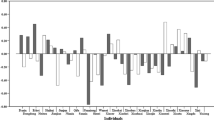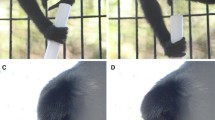Abstract
The evolutionary origin of human right-handedness remains unclear. Many factors such as emotion and tool use have been implicated in primate handedness evolution. With regard to emotional lateralization, most related research focuses on facial asymmetry and behavioral laterality under the non-social context, whereas few studies investigate social laterality. This study, for the first time, investigates the effect of target animacy on hand preference in Old World monkeys, compares our findings with previous related studies in great apes and humans, and aids in filling the knowledge gap on primate handedness evolution. Nine captive northern pig-tailed macaques (Macaca leonina) were chosen as focal subjects in this study. There was no group-level handedness for both animate and inanimate targets. No significant interaction was found between lateral hand use and target animacy. Left-hand use was more frequent than right-hand use for animate targets, whereas right-hand use was more frequent than left-hand use for inanimate targets, both of which demonstrate no significant level. On the whole, northern pig-tailed macaques showed a similar tendency as that in great apes and humans. Regarding handedness linked with emotive stimuli, it is likely that Old World monkeys, great apes and humans evolved from a common ancestor.

Similar content being viewed by others
References
Annett M (2002) Handedness and brain asymmetry: the right shift theory. Psychology Press, Hove
Baraud I, Buytet B, Bec P, Blois-Heulin C (2009) Social laterality and ‘transversality’ in two species of mangabeys: influences of rank and implication for hemispheric specialization. Behav Brain Res 198:449–458
Borod JC, Cicero BA, Obler LK, Welkowitz J, Erhan HM, Santschi C, Grunwald IS, Agosti RM, Whalen JR (1998) Right hemisphere emotional perception: evidence across multiple channels. Neuropsychology 12:446–458
Boyed R, Silk JB (2000) How humans evolved. WW Norton, NewYork
Bradshaw J, Rogers LJ (1993) The evolution of lateral asymmetries, language, tool use and intellect. Academic Press, San Diego
Campbell R (1982) Asymmetries in moving faces. British J Psychol 73:95–103
Cashmore L, Uomini N, Chapelain A (2008) The evolution of handedness in humans and great apes: a review and current issues. J Anthropol Sci 86:7–35
Casperd JM, Dunbar RIM (1996) Asymmetries in the visual processing of emotional cues during agonistic interactions by gelada baboons. Behav Process 37:57–65
Cochet H, Byrne RW (2013) Evolutionary origins of human handedness: evaluating contrasting hypotheses. Anim Cogn 16:531–542
Corballis MC (2002) From hand to mouth: the origins of language. Princeton University Press, Princeton
Corballis MC (2003) From mouth to hand: gesture, speech, and the evolution of right-handedness. Behav Brain Sci 26:199–260
Davidson RJ (1995) Cerebral asymmetry, emotion, and affective style. In: Davidson RJ, Hugdahl K (eds) Brain asymmetry. MIT Press, Cambridge, pp 361–387
Demaree HA, Everhart DE, Youngstrom EA, Harrison DW (2005) Brain lateralization of emotional processing: historical roots and a future incorporating “dominance”. Behav Cognit Neurosci Rev 4:3–20
Dimond S, Harries R (1983) Face touching in monkeys, apes and man: evolutionary origins and cerebral asymmetry. Neuropsychologia 22:227–233
Elango N, Lee J, Peng ZG, Loh YHE, Yi SV (2009) Evolutionary rate variation in Old World monkeys. Biol Lett 5:405–408
Fagot J, Vauclair J (1991) Manual laterality in nonhuman primates: a distinction between handedness and manual specialization. Psychol Bull 109:76–89
Fernandez-Carriba S, Loeches Á, Morcillo A, Hopkins WD (2002) Asymmetry in facial expression of emotions by chimpanzees. Neuropsychologia 40:1523–1533
Forrester GS, Leavens DA, Quaresmini C, Vallortigara G (2011) Target animacy influences gorilla handedness. Anim Cogn 14:903–907
Forrester GS, Quaresmini C, Leavens DA, Spiezio C, Vallortigara G (2012) Target animacy influences chimpanzee handedness. Anim Cogn 15:1121–1127
Forrester GS, Quaresmini C, Leavens DA, Mareschal D, Thomas MSC (2013) Human handedness: an inherited evolutionary trait. Behav Brain Res 237:200–206
Forrester GS, Crawley M, Palmer C (2014) Social environment elicits lateralized navigational paths in two populations of typically developing children. Brain Cogn 91:21–27
Gilissen EP, Hopkins WD (2013) Asymmetries of the parietal operculum in chimpanzees (Pan troglodytes) in relation to handedness for tool use. Cereb Cortex 23:411–422
Greenfield PM (1991) Language, tools, and brain: the ontogeny and phylogeny of hierarchically organized sequential behavior. Behav Brain Sci 14:531–550
Harmon-Jones E, Gable PA, Peterson CK (2010) The role of asymmetric frontal cortical activity in emotion-related phenomena: a review and update. Biol Psychol 84:451–462
Hauser MD (1993) Right hemisphere dominance for the production of facial expression in monkeys. Science 261:475–477
Higuchi S, Chaminade T, Imamizu H, Kawato M (2009) Shared neural correlates for language and tool use in Broca’s area. Neuroreport 20:1376–1381
Hook-Costigan MA, Rogers LJ (1998) Lateralized use of the mouth in production of vocalizations by marmosets. Neuropsychologia 36:1265–1273
Hopkins WD (1999) On the other hand: statistical issues in the assessment and interpretation of hand preference data in nonhuman primates. Int J Primatol 20:851–866
Hopkins WD (2007) The evolution of hemispheric specialization in primates. Academic Press, San Diego
Hopkins WD (2013a) Comparing human and nonhuman primate handedness: challenges and a modest proposal for consensus. Dev Psychobiol 55:621–636
Hopkins WD (2013b) Independence of data points in the measurement of hand preferences in primates: statistical problem or urban myth? Am J Phys Anthropol 151:151–157
Hopkins WD, Wesley MJ (2002) Gestural communication in chimpanzees (Pantroglodytes): the influence of experimenter position on gesture type and hand preference. Laterality 7:19–30
Hopkins WD, Russell JL, Cantalupo C (2007) Neuroanatomical correlates of handedness for tool use in chimpanzees (Pantroglodytes): implication for theories on the evolution of language. Psychol Sci 18:971–977
Hopkins WD, Reamer L, Mareno MC, Schapiro SJ (2015) Genetic basis in motor skill and hand preference for tool use in chimpanzees (Pan troglodytes). Proc R Soc B 282:20141223
Knecht S, Drager B, Deppe M, Bobe L, Lohmann H, Floel A, Ringelstein EB, Henningsen H (2000) Handedness and hemispheric language dominance in healthy humans. Brain 123:2512–2518
Leliveld LMC, Langbein J, Puppe B (2013) The emergence of emotional lateralization: evidence in non-human vertebrates and implications for farm animals. Appl Anim Behav Sci 145:1–14
Levy J (1977) The mammalian brain and the adaptive advantage of cerebral asymmetry. Ann NY Acad Sci 299:264–272
Lindell AK (2013) Continuities in emotion lateralization in human and non-human primates. Front Hum Neurosci 7:464
MacNeilage PF, Rogers LJ, Vallortigara G (2009) Origins of the left and right brain. Sci Am 301:60–67
Marchant LF, McGrew WC (1998) Human handedness: an ethological perspective. Hum Evol 13:221–228
McManus IC (2002) Right hand, left hand. Weidenfeld and Nicolson, London
Porac C, Coren S (1981) Lateral preferences and human behavior. Springer, New York
Quaresmini C, Forrester GS, Spiezio C, Leavens DA, Vallortigara G (2014) Social environment elicits lateralized behaviors in gorillas (Gorilla gorilla gorilla) and chimpanzees (Pan troglodytes). J Comp Psychol 128:276–284
Rogers LJ (2014) Asymmetry of brain and behavior in animals: its development, function, and human relevance. Genesis 52:S555–S571
Rogers LJ, Andrew RJ (2002) Comparative vertebrate lateralization. Cambridge University Press, Cambridge
Rogers LJ, Kaplan G (1996) Hand preferences and other lateral biases in rehabilitated orangutans, Pongo pygmaeus pygmaeus. Anim Behav 51:13–25
Rosa Salva O, Regolin L, Mascalzoni E, Vallortigara G (2012) Cerebral and behavioural asymmetry in animal social recognition. Comp Cogn Behav Rev 7:110–138
Rutherford HJV, Lindell AK (2011) Thriving and surviving: approach and avoidance motivation and lateralization. Emot Rev 3:333–343
Stewart CB, Disotell TR (1998) Primate evolution-in and out of Africa. Curr Biol 8:R582–R588
Stout D, Chaminade T (2012) Stone tools, language and the brain in human evolution. Phil Trans R Soc B 367:75–87
Uomini N (2009) The prehistory of handedness: archaeological data and comparative ethology. J Hum Evol 57:411–419
Uomini NT, Meyer GF (2013) Shared brain lateralization patterns in language and Acheulean stone tool production: a functional transcranial Doppler ultrasound study. PLoS One 8:e72693
Vallortigara G, Rogers LJ (2005) Survival with an asymmetrical brain: advantages and disadvantages of cerebral lateralization. Behav Brain Sci 28:575–589
Wallez C, Vauclair J (2012) First evidence of population-level oro-facial asymmetries during the production of distress calls by macaque (Macacamulatta) and baboon (Papioanubis) infants. Behav Brain Res 234:69–75
Wallez C, Vauclair J (2013) Human (Homo sapiens) and baboon (Papio papio) chimeric face processing: right-hemisphere involvement. J Comp Psychol 127:237–244
Ward JP, Hopkins WD (1993) Primate laterality: current behavioral evidence of primate asymmetries. Springer, New York
Zhao DP, Gao X, Li BG (2010) Hand preference for spontaneously unimanual and bimanual coordinated tasks in wild Sichuan snub-nosed monkeys: implication for hemispheric specialization. Behav Brain Res 208:85–89
Zhao DP, Hopkins WD, Li BG (2012) Handedness in nature: first evidence of manual laterality on bimanual coordinated tube task in wild primates. Am J Phys Anthropol 148:36–44
Acknowledgments
We appreciate animal keepers of the Tianjin Zoo for their assistance during data collection. This study was funded by Talent Introduction Fund of Tianjin Normal University of China (No. 5RL115) and “More Than One Thousand Talents Introduction within 3 years” Fund of Tianjin City of China (No. 5KQM110002).
Conflict of interest
The authors declare that they have no conflict of interest.
Ethical standard
All applicable international and Chinese guideline for the care and use of animals were followed.
Author information
Authors and Affiliations
Corresponding author
Rights and permissions
About this article
Cite this article
Zhao, D., Wang, Y., Han, K. et al. Does target animacy influence manual laterality of monkeys? First answer from northern pig-tailed macaques (Macaca leonina). Anim Cogn 18, 931–936 (2015). https://doi.org/10.1007/s10071-015-0863-3
Received:
Revised:
Accepted:
Published:
Issue Date:
DOI: https://doi.org/10.1007/s10071-015-0863-3




